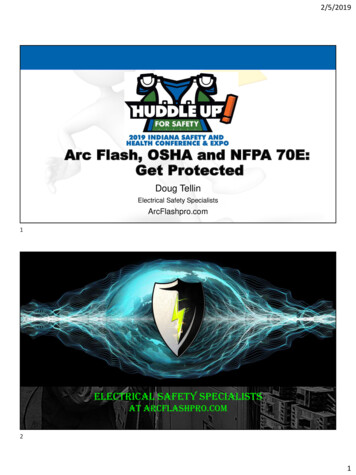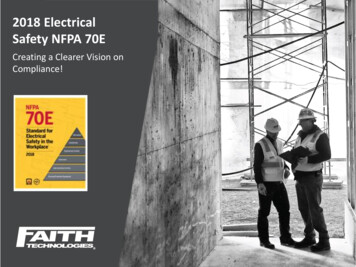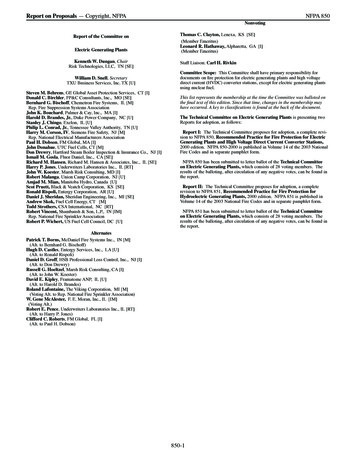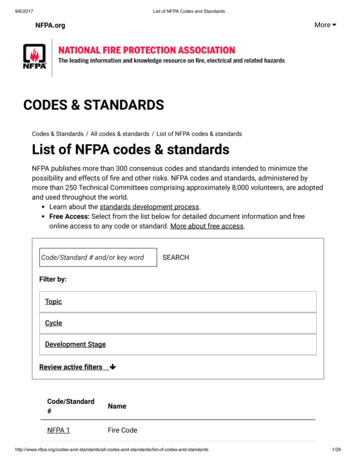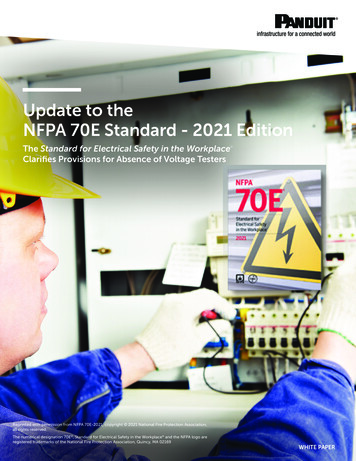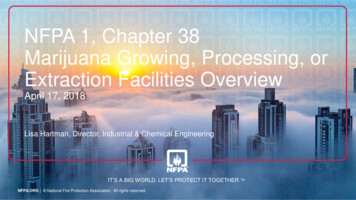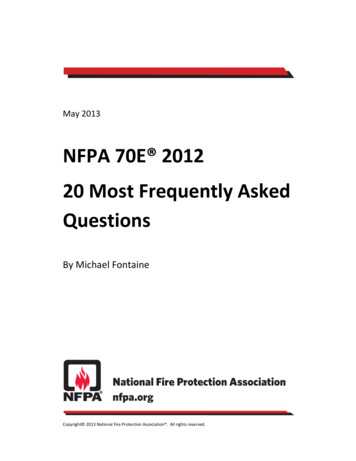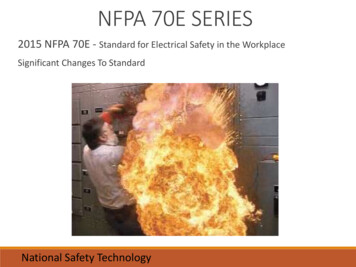
Transcription
NFPA 70E SERIES2015 NFPA 70E - Standard for Electrical Safety in the WorkplaceSignificant Changes To StandardNational Safety Technology
NFPA 70E Requirements for safe work practices Addresses hazards: Shock Arc Flash/Blast Requirements forshock and arc flashboundaries Requirementspersonal protectiveequipment Additional Training Requirements to beconsidered “Qualified” Energized Electrical Work PermitNATIONAL SAFETY TECHNOLOGY
Significant Changes in 2015 Standard Safety Related Maintenance Requirements 90.2(A)“Bare Hand Work” – Best served by “utility regulations”‘Energized Work Permit’ - Definition Updated 130.2(B)(1)‘Qualified Person’ re-defined to correlate with OSHA 1910.399Removal of “Prohibited Approach Boundary”New requirements for Electrical Safety Program to includecondition of maintenance 110.1(B)Audit of field work compliance not to exceed 1 year 110.1(I)(2)Location, sizing, application of temporary grounding identifiedas part of job planning 120.3(A)Clarification of ‘Normal Operation’ 130.2(A)(4)Incident Energy vrs Clothing Category 130.5(D)Field Marking Requirements process changes 130.5(D)NATIONAL SAFETY TECHNOLOGY
Significant Changes in 2015 Standard Boundary Changes 130.6(D) Conductive Objects 130.6(D) PPE Table Changes 130.7(C)(15)(A)(a) – 130.7(C)(15)(A)(b) 130.7(C)(15)(B) Removal/Redefine of ‘Category 0’ 130.7(C)(16) Insulated Tool requirements 130.7(D)(I) Barricade Requirements 130.7(E)(2) Risk Assessment Before Cutting or Drilling 130.10 Host Company (Owner) responsibility 205.3 Test instrument requirements 110.4(A)(5) – 250.4 Battery Risk Assessment 320.3(A)(1) – 320.3(A)(1)NATIONAL SAFETY TECHNOLOGY
Safety Training RequirementsNFPA 70E 110.2 All employees who face a risk of electricalhazards. Trained to understand the specific hazards. Trained in safety related work practices. Trained in procedural requirements for PersonalProtective Equipment (PPE) Trained to understand the relationship betweenthe hazard and possible injury Emergency Procedures – Employs Exposed Methods of release Regularly Instructed In CPR & AED and verified annuallyNATIONAL SAFETY TECHNOLOGY
Electrical Safety Program 110.1The employer shall implementand document an overall electricalsafety program that directs activityappropriate to the risk associatedwith electrical hazards.The electrical safety program shallbe implemented as part of theemployer’s overall occupationalhealth and safety managementsystem, when one exists.NATIONAL SAFETY TECHNOLOGY
Electrical Safety Program 110.1Elements of the program shall include: Maintenance Consideration of condition Awareness and Self Discipline Program Principals Basis of program Examples in annex ‘E’ Control How Measured and Monitored Procedures for Safe Work Risk Assessments Job Briefing Requirements Annex ‘I’ Audit RequirementsNATIONAL SAFETY TECHNOLOGY
“Qualified”person“A qualified person shall be trained andknowledgeable in the construction and operationof equipment or a specific work method and betrained to identify and avoid the electrical hazardsthat may be present with respect to thatequipment or work method”
“Qualified” personAdditional requirements:Trained to recognize the hazards presentSuch persons shall also be familiar with The use of the precautionary techniques Electrical policies and procedures Personal protective equipment Insulating and shielding materials Insulated tools and test equipment
“Qualified” personIn addition, to be permitted to work within the limited approach ofexposed energized conductors and circuit parts 50Volts. shall betrained in all of the following:o The skills and techniques necessary to distinguish exposed live parts fromother parts of electric equipmento The skills and techniques necessary to determine the nominal voltage ofexposed live partso The minimum approach distances specified in this section corresponding tothe voltages to which the qualified employee will be exposed, and,o The decision making process necessary to be able to do the following:o Perform the job safety planningo Identify electrical hazardso Assess the associated risko Select the appropriate risk control methods from the hierarchy of controls (110.1(G)) including proper PPE
Dangers of ElectricityElectric ShockArc FlashArc Blast
By The NumbersHow OftenNumberEffectUnited StatesAnnual Average4,000Non-Disabling electrical contact injuriesUnited StatesAnnual Average3,600Disabling electrical contact injuriesEvery DayElectrocutions areEach year14th 2,000Person is electrocuted in the workplaceLeading cause of traumatic occupational fatalitiesWorkers are sent to burn centers with electricalburns An average of one person is electrocuted in thehome every 36 hours Electrocution is fourth in work related fatalities witha majority of these incidents occurring at 600 voltsor less There are four main types of electrical injuries:
Electrocution and ShockFactors that determineseverity of electric shock Amount of current Path of current Duration of shock Body Resistance Voltage Frequency AC or DC
Current MagnitudesCURRENTA/CPHYSIOLOGICALPHENOMENAFEELING OR LETHALINCIDENCE60HZ 1mA1mA2-10mANoneDC CurrentPhysiologicalPhenomenaNot painful, muscle controlmaintained0-4 mAPerceptionThresholdGround Fault Circuit InterrupterOperates4-15 mASurprise15-80 mAReflex Action80-160 mAMuscularInhibition160-300 mARespiratoryFailure 300 mAUsually FatalImperceptiblePerception thresholdSensation of shock5mA10-20mAParalysis Threshold of ArmsCannot release hand grip, victimmay be thrown clear20-50mARespiratory ParalysisBreathing Stoppage (frequentlyfatal)50-100mAFibrillation Threshold (0.5%)Heart action discoordinated(probably fatal)100200mA 200mAFibrillation Threshold(99.5%)Tissue BurningNon fatal unless vital organs areburned
Typical Human Resistor ValuesAccidental contact with the HV battery of a hybrid car, aphotovoltaic array, DC charging station. If the insulation is faulty,it is possible that the following current flows:Hand – to – HandI E/R 288V/1000ohm .288A 288mA
First AidSome basic first aidpracticesThis section is notintended to replace firstaid trainingNATIONAL SAFETY TECHNOLOGY
Immediate ResponseContact Release Shall be trained in methods of safe release Annual refresher requirementNATIONAL SAFETY TECHNOLOGY
First Aid TrainingOSHA 1910.269 (b)“When employees are performing work on or associated withexposed lines or equipment energized at 50 volts or more, personstrained in first aid including cardiopulmonary resuscitation (CPR)and (AED) shall be trained and available” AND anybody workinginside the limited approach.“At a fixed location (i.e. shop, plant, etc.), ensure that enoughpeople are trained in first aid so that a victim can be reachedwithin four minutes. At remote fixed locations where this may notbe possible, then all of the individuals working must be first aidtrained”NATIONAL SAFETY TECHNOLOGY
First Aid Training110.2(C)(2) – (3) – (4)First Aid, Emergency Response, and Resuscitation.(a) Employees responsible for responding to medical emergencies shall be trained infirst aid and emergency procedures.(b) Employees responsible for responding to medical emergencies shall be trained incardiopulmonary resuscitation (CPR). Refresher training shall occur annually.(c) Employees responsible for responding to medical emergencies shall be trained inthe use of an automated external defibrilator (AED) if an employer’s emergencyresponse plan includes the use of this device. Refresher training shall occur annually.Training Verification.Employers shall verify at least annually that employee training required by thissection is current.Documentation.The employer shall document that the training required by this section hasoccurred.NATIONAL SAFETY TECHNOLOGY
Response to Electric ShockIMMEDIATE - Confusion, amnesia,headache, breathing stops, heartstops, burnSECONDARY - Paralysis, muscularpain, vision abnormalities, swelling,headache, and cardiac irregularitiesLONG RANGE - Paralysis,speech/writing disorders, loss oftaste, and other disorders as a resultof nerve tissue damage
Electrical BurnsMost common shock-related, nonfatal injuryOccurs when you touch electrical wiring or equipment that isimproperly used or maintainedTypically occurs on the handsVery serious injury that needs immediate attentionNATIONAL SAFETY TECHNOLOGY
ARC FLASH
Arc Flash An arc flash occurs when electrical current passes through air This most often occurs in power systems when: Making or breaking a circuit Bridging a insulating air gap with a more conductive object The heat generated can be devastating A fire usually burns at 800-1000 degreesSteel melts at around 1,800 degreesThe surface of the sun is estimated to be about 7,000 degreesAn arc flash can be up to 36,000 degrees! That’s 20 times the temperature thatsteel melts and 5 times as hot as the sun! This extreme heat causes other hazardsNATIONAL SAFETY TECHNOLOGY
Arc Flash HazardsHeat – An arc flash can be up to36,000 degrees FR clothing can minimize extent of burns FR clothing is available up to 100 Cal/cm2Ultraviolet (UV) light Can cause damage to retinas, possiblecausing blindness Coating on eye protection is designed tofilter out some of the UV lightNATIONAL SAFETY TECHNOLOGY
Arc Flash HazardsPressure When copper vaporizes it expands to67,000 times the volume of solid copper The air in the vicinity of the arc is heatedand expands rapidly A study conducted by Dr. Ralph Leerevealed that a 10kV – 100kA arc created apressure of 400 lbs/ft2 at a distance of 3.3feet! This is about 10 times the pressure aconventional wall is built to withstand sosuch an arc could destroy a conventionalwall from 40 feet away!
Arc Flash Event 10-15-2012GlovesArc Rated Face ShieldCircumstance:A Facility associate was changing a breaker ina 480 volt MCC panel.When connecting the wire to the lug, theenergized line wire grounded causing an arcblast / flash. Panel was identified as a HRC 2.Breaker CubicalPPE Used and Identified on the panel label Class 00 gloves with outer leather protectors Cotton undershirt Cotton long sleeve shirt FR HRC rated outer clothing Cotton pants Ear plugs Hard hat with arc flash shield.The associate sustained no injury due to following electrical safety work practices.DMAT’s training and foresight prevented a serious injury during high risk work.
Flash Hazard AnalysisThere are several methods used to determine the incident energy of an arc flash event: Use the tables from the NFPA 70E (Recently Updated) The tables have limitations (Notes section)They make several assumptionsBest used as a temporary solution‘in lieu of’ Use the NFPA 70E equations (Lee method) Simple, can be done by hand using a calculator Spread Sheet Use the IEEE 1584 equations Most accurate method, but very complicated Purchase a software suite (SKM, ETAP, EasyPower, to name a few) Very expensive but easy to use Contract someone else to do it Probably the best solution for smaller companies
130.3.A.1 2015 Actioin Based Risk Table Example
Label RequirementsElectrical equipment such as switchboards, panelboards, industrialcontrol panels, meter socket enclosures, and motor control centersthat are in other than dwelling units and that are likely to requireexamination, adjustment, servicing, or maintenance while energizedshall be field-marked with a label containing all the followinginformation:(1) Nominal system voltage(2) Arc flash boundary(3) At least one of the following: Available incident energy and the corresponding working distance,or the arc flash PPE category in Table 130.7(C)(15)(A)(b) or Table130.7(C)(15)(B) for the equipment, but not both Minimum arc rating of clothing Site-specific level of PPE
NFPA 70 E 2012‘ shall be field marked, with all label containing allthe following’At least one of the following:-Incident Energy & Working Distance-Clothing HRC Rating-Required PPE-Highest Equipment HRCNominal System VoltageArc Flash BoundaryNEC REQUIREMENTS FOR LABELING
Personal Protective Equipment
Personal Protective EquipmentShock Protection
Personal Protective EquipmentFlash Protection
F-1506 Label Arc Thermal Performance Value (ATPV) is defined as the arc incident energyrequired to cause the onset of second-degree burn and is represented incal/cm2 This rating is the result of a testing procedure (ASTM F-1959) thatmeasures the amount of thermal protection a FR fabric would give a wearer ifthe person were exposed to an electric arc. Alternatively the material may have an EBT (Energy Break-open Threshold)rating. EBT is defined as the average of the 5 highest incident energy exposurevalues below the Stoll curve where the specimen did not exhibit break-open.EBT is reported when ATPV cannot be measured due to FR fabric break open.
Typical Protective ClothingBasic Electrical PPE Category – 0Protective Clothing –Nonmelting or UntreatedNatural Fibers 4.5oz/yd2Shirt - Long SleevePants – LongFR Protective EquipmentSafety GlassesHearing Protection – Ear Canal InsertLeather Gloves – (AN)PPE Level0 to 1.2 Cal / cm2
Typical Protective ClothingHazard Risk Category – 2FR Minimum ArcRating of 8Arc Rated Long Sleeve ShirtArc Rated PantsArc Rated CoverallArc Rated Face Shield and BalacavaArc Flash Suit HoodArc Rated Jacket, Parka or Rainwear (AN)FR ProtectiveEquipmentHard HatSafety Glasses or Safety Goggles (SR)Hearing Protection (Ear Canal Inserts)Leather GlovesLeather Work Shoes
Typical Protective ClothingHazard Risk Category – 4FR Minimum Arc Arc Rated Long Sleeve Shirt (AR) (Note 9)Rating of 40Arc Rated Pants (AR) (Note 9)(Note 1)Arc Rated Coverall (AR) (Note 9)Arc Rated Flash Suit Jacket (AR) (Note 9)Arc Rated Flash Suit Pants (AR) (Note 9)Arc Rated Flash Suit Hood (Note 9)Arc Rated Jacket, Parka or Rainwear (AN)FR ProtectiveEquipmentHard HatFR Hard Hat Liner (AR)Safety Glasses or Safety Goggles (SR)Hearing Protection (Ear Canal Inserts)Arc Rated Gloves (Note 2)Leather Work Shoes
Safety GlovesEmployees shall wearrubber insulating gloveswhere there is a danger ofarm and hand injury fromelectrical shock and burnsdue to contact with liveparts.Gloves used shall be of theappropriate voltage classNATIONAL SAFETY TECHNOLOGY
Glove selectionGlove size is important toensure a proper fit anddexteritySize is inches around thepalm of your handLeather Protectors: Required for penetrationprotection If gloves used without, thenmust be re-tested prior to nextuseNATIONAL SAFETY TECHNOLOGY
NATIONAL SAFETY TECHNOLOGY
Glove Testing(Courtesy Reed City Power Line)Gloves are required to be labtested:- Prior to first use- Every six months- Prior to next use if usedwithout protectorsThe tests include: Dielectric test at voltage onprevious chart Air test Cleaning Visual inspection
Glove inspectionAir testGloves shall be inspected prior toeach useThe inspection should include:Visual inspection checking for: Cracks Punctures Ozone damage Snags Embedded materialNATIONAL SAFETY TECHNOLOGY
TOOL & TEST EQUIPMENTUSE AND SAFETY
Electrical test equipment Inspection Visually check meter for: UL listed (or equivalent)– Double insulatedProbes should be inspected for: Shrouded connectors, finger guards Insulation not melted, cut, cracked,etc. Probe tips: not loose or broken off
Electrical test equipment InspectionFinally, ensure the meter andleads are rated for theinstallation category you will beworking inNATIONAL SAFETY TECHNOLOGY
Hot stick / ShotgunsInsulated tools for working on energized partsWood PVC or fiberglassInspected for: Integrity Cleanliness InsulationTested every 2 years if primary means of protectionNATIONAL SAFETY TECHNOLOGY
Job BriefBefore starting each job, the employee in chargeshall conduct a job briefing with the employeesinvolved.Documented Job Briefs Energized Work Permit Complex LOTO Contractors onsiteThe briefing shall cover such subjects as: Hazards associated with the jobWork procedures involvedSpecial precautionsEnergy source controlsPersonal Protective Equipment RequirementsNATIONAL SAFETY TECHNOLOGY
LOTO ProceduresThere are three forms of hazardousenergy control : Individual employee control(Removed By Amendment To TheOSHA Act) Ex-Clean/Inspect No lock required if disconnect is visible Simple lockout/tagout Qualified person performing lockout for solepurpose of work Not required to be written for eachapplication Complex lockout/tagout Written plan Designated person in charge Documented Job Brief
Energized Electrical Work PermitJustificationFrom label or equationPer table 130.7(C)(10)Per Table 130.7(C)(9)(a)Per table 130.2(C)2 Qualified persons mustagree it is safeAuthorizationNATIONAL SAFETY TECHNOLOGY
2015LIMITSOFAPPROACHNATIONAL SAFETY TECHNOLOGY
NFPA 70E Approach BoundariesFROM NFPA 70E(2012) 130.4Alternating Current (AC) Shock Protection BoundariesLimitedVoltage RangeMovableFixedRestrictedProhibited0-50 VACNot SpecifiedNot SpecifiedNot Specified51-300 VAC10’0”3’ 6”Avoid ContactAvoid Contact301-750 VAC10’0”3’ 6”12”1”Direct Current (DC) Shock Protection BoundariesVoltage Range0-100 VDC100-300 VDC301-1000 VCDLimitedMovable FixedNot Specified10’0”3’6”10’0”3’ 6”RestrictedNot SpecifiedAvoid Contact12”ProhibitedNot SpecifiedAvoid Contact1”NATIONAL SAFETY TECHNOLOGY
Trained and competentYou are not 10 foot tall and bulletproof!There is no substitute for experienceBE SAFE!!!NATIONAL SAFETY TECHNOLOGY
NATIONAL SAFETY TECHNOLOGY
National Safety TechnologyKevin D. ResideNational Safety Director / Arc Flash SpecialistBOX 381Walled Lake, MI 48390248-757-0627 (P)248-598-1861 (F)248-461-7070 (C)517-6-SAFETY onal-safety.netUS NAVY RETIRED - Disabled Veteran Owned
NFPA 70E 110.2 All employees who face a risk of electrical hazards. Trained to understand the specific hazards. Trained in safety related work practices. Trained in procedural requirements for Personal Protective Equipment (PPE) Trained to understand the relationship between the hazard and possible injury
